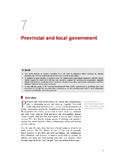Transcription of Social security and the social wage - National …
1 816 Social security and the Social wage In brief The National Development Plan (NDP) recognises that reducing the cost of living is essential for broadening economic participation and eliminating poverty. Alongside the economic wage earned through work, the Social wage provided by government represents a steadily rising contribution to improved living conditions of working people and their families. Spending on Social development, health, education, housing and local amenities has more than doubled in real terms over the past decade and now accounts for almost 60 per cent of public expenditure. In the fiscally constrained period ahead, the emphasis will need to be on improved value for money. Social assistance provides a safety net for the most vulnerable and will contribute to the monthly incomes of over 16 million people in 2013.
2 Social development spending has improved living conditions over the past decade, but service delivery must be improved through shared efforts between government, the private sector and civil society. Further steps in retirement reform, improvements in contributory Social insurance and piloting of National health insurance reforms will progress over the medium term, reinforcing the links between earnings, Social services and income support. Overview he state s contribution to poverty reduction and Social development is substantial and wide-ranging. As emphasised in the NDP, reducing the cost of living for low-income and working-class households is essential for broadening economic participation and inclusive growth. Government contributes to reducing the cost of living in three ways: Investment in the Social wage , comprising education, health services, Social development, public transport, housing and local amenities.
3 T Social expenditure lowers the cost of living for poor and working-class households 2013 BUDGET REVIEW 82 Support to vulnerable households through the old age grant, the child support grant and other Social assistance grants. Contributory Social security , including unemployment insurance, injury compensation and death or disability benefits. The Social wage and economic growth Decent work is about both earned income and the living conditions of working people. Employment and productivity advances can be reinforced by improvements in education, health care, housing and other services. These, in turn, will have greater impact on reducing poverty and inequality if accompanied by more rapid job creation and enterprise development. South Africa s medium-term fiscal constraints underline the need for accelerated growth, because the fiscus cannot carry the entire burden of Social development.
4 South Africa confronts high levels of poverty and inequality. Figure shows the distribution of individual earnings across the working population, indicating that over 60 per cent of working people earn less than the tax threshold of about R5 000 a month. Figure also shows the principal means tests associated with different public services. Parents or caregivers earning less than R2 800 per month are eligible for the child support grant, which pays R280 per month for each child they are looking after. Some of these tests apply to households: where a household earns less than R3 500 per month, it qualifies for a housing subsidy currently worth R84 000. Figure Means tests and the distribution of income Source: National Treasury This illustration shows how the thresholds for Social assistance, housing and free health care accommodate a substantial proportion of the population.
5 Improving the quality and reach of education, public health, housing, municipal amenities and welfare services is therefore central to reducing poverty and improving the living conditions of working people and their families. 02 0004 0006 0008 00010 00012 00014 00016 00018 00020 0001 5 9 142127323945505560667177818792 Monthly income (Rands)Percentile of income distributionIncome distribution of working populationThreshold for free basic services and no fee schools (household)Child support grantThreshold for free housing (household)Old age and disability grantsTax thresholdCut-off for subsidised public health careFaster growth is needed because the fiscus cannot carry the entire burden of Social development Improving quality and reach of education, health, housing and services is central to Social development CHAPTER 6: Social security AND THE Social wage 83 Expanding opportunities for work and improving earnings are also essential.
6 South Africa s human development challenge and the goals of the NDP are addressed both through public investment in the Social wage and expanded participation in employment and economic growth. Close to 60 per cent of government spending is allocated to the Social wage . As Figure shows, expenditure on these services has more than doubled in real terms over the past decade. As a percentage of GDP, spending on the Social wage has risen from 13 per cent to 19 per cent over the same period. Social assistance pays an income directly to vulnerable households, while the other public services that make up the Social wage replace or subsidise day-to-day expenses such as housing, education and amenities, reducing the cost of living . Figure Spending on the Social wage , 2002/03 2012/13 *2012/13 is an estimate Source: National Treasury An expression of Social solidarity The Social wage achieves a redistribution of income and opportunities through the fiscus, partly because benefits are directed on the basis of need, and partly because costs are met through a progressively structured tax This gives practical expression, in South Africa s circumstances, to the principle of Social solidarity.
7 Substantial growth in Social spending over the past decade has financed a threefold increase in the number of people receiving Social grants, a doubling in per capita health spending, the construction of million free homes and the provision of free basic education to the poorest 60 per cent of learners. The impact is evident in improved living standards, expanded access to basic services and the changing urban/rural landscape. 1 Van der Berg, Servaas. 2009. Fiscal incidence of Social spending in South Africa, 2006. Available at 01002003004005006007002002/032006/072009 /102012/13*R billion (2012 rands)Housing and community amenitiesHealthEducationSocial protectionSocial wage has more than doubled in real terms since 2002 Social wage achieves a progressive redistribution of income and opportunities through the fiscus 2013 BUDGET REVIEW 84 While access to services has expanded rapidly, there is much to be done to improve the management and effectiveness of Social services, and to strengthen development coordination at local level between government, the private sector and civil society partners.
8 There also has to be progressive growth in household income from productive economic activity. This chapter provides an overview of Social assistance and relief programmes supporting the unemployed and most vulnerable, and broader investment in Social services aimed at improving living conditions for all. It summarises contributory Social security arrangements and the status of retirement reform and National health insurance (NHI). Social assistance and welfare services The Social assistance programme provides a regular income to South Africa s most vulnerable households and is government s most direct means of combating poverty. By the end of 2012/13, nearly million people were beneficiaries of Social grants, up from million in 1998.
9 Most of this increase relates to the expansion of the child support grant. More than half of all households benefit from Social assistance. For 22 per cent of households, Social grants are the main source of income. Social grants are funded directly through the fiscus and will contribute R113 billion to the income of low-income households in 2013/14. Access to Social grants has been broadened in recent years by raising the means test income thresholds. The number of child support grant beneficiaries has risen from million in 2004/05 to about million as a result of the increase in the eligibility age to a child s 18th birthday. An impact study conducted in 2012 found that receipt of this grant promotes early childhood development, improves educational outcomes, and contributes to better nutrition and Table shows the adjustments for grants in 2013/14.
10 The old age, war veterans, disability and care dependency grants will increase by R60. The foster care grant will increase by R30 and the child support grant by R10 in April and a further R10 in October 2013. 2 Department of Social Development, South African Social security Agency and United Nations Children s Fund. 2012. The South African Child Support Grant Impact Assessment: Evidence from a survey of children, adolescents and their households. Pretoria: UNICEF South Africa. Table Monthly Social grant values, 2012/13 and 2013/14 Rand2012/132013/14 IncreaseOld age grant1 200 1 260 age grant, over 75s1 220 1 280 veterans grant1 220 1 280 grant1 200 1 260 care grant770 800 dependency grant1 200 1 260 support grant1280 290 Value will increase to R300 in October 2013 About 16 million people benefit from Social grants, up from million in 1998 million children benefit from child support grant Adjustments for all grants compensate for effects of inflation CHAPTER 6: Social security AND THE Social wage 85 Table shows beneficiary numbers by Social grant and by province.
















